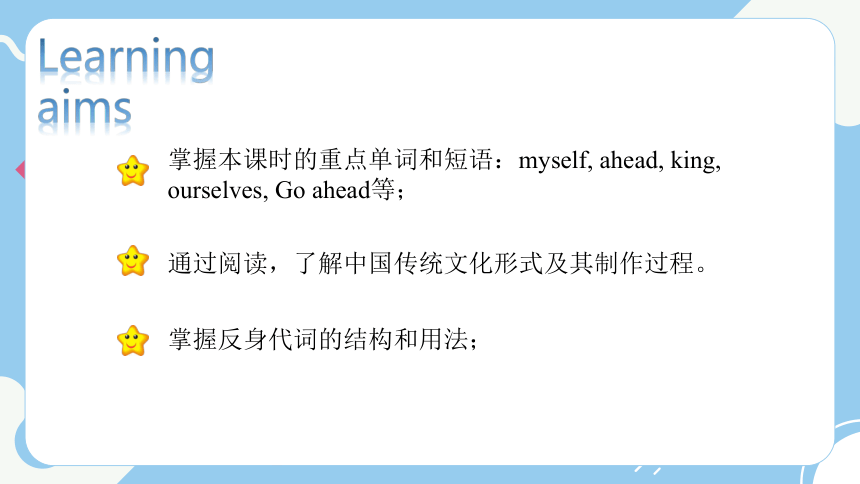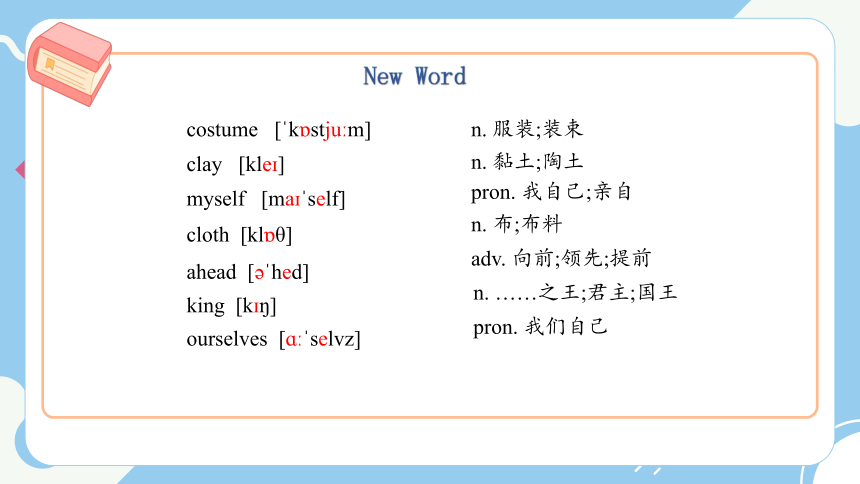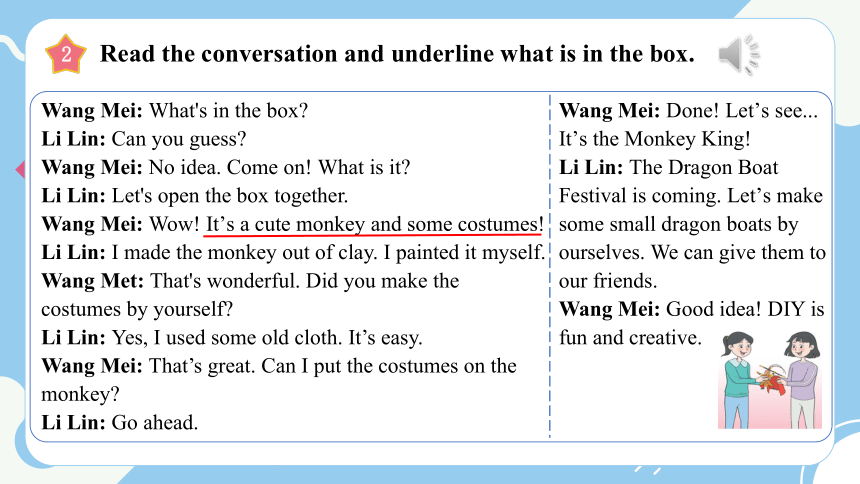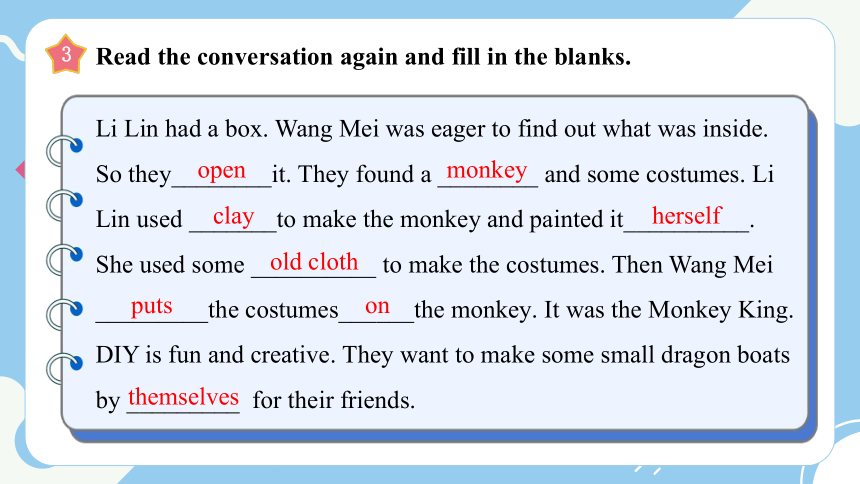Unit 6 Being creative Lesson 3 课件(共25张PPT,内嵌视频) 2024-2025学年英语冀教版七年级下册
文档属性
| 名称 | Unit 6 Being creative Lesson 3 课件(共25张PPT,内嵌视频) 2024-2025学年英语冀教版七年级下册 |  | |
| 格式 | pptx | ||
| 文件大小 | 13.5MB | ||
| 资源类型 | 教案 | ||
| 版本资源 | 冀教版 | ||
| 科目 | 英语 | ||
| 更新时间 | 2025-04-22 06:04:33 | ||
图片预览









文档简介
(共25张PPT)
Being creative
Lesson 3: What is in the box
Unit 6
Learning aims
掌握反身代词的结构和用法;
掌握本课时的重点单词和短语:myself, ahead, king, ourselves, Go ahead等;
通过阅读,了解中国传统文化形式及其制作过程。
New Word
costume [ k stju m]
n. 服装;装束
clay [kle ]
n. 黏土;陶土
myself [ma self]
pron. 我自己;亲自
cloth [kl θ]
n. 布;布料
ahead [ hed]
adv. 向前;领先;提前
king [k ]
n. ……之王;君主;国王
ourselves [ɑ selvz]
pron. 我们自己
Lead-in
What’s the video about
Look at the pictures and answer the questions.
A What animals they are
B Can you make them
They are a rabbit, a bird, a rooster and a goldfish.
Yes, I can./No, I don’t.
Activity 1
: To understand what’s in the box
1
Wang Mei: What's in the box
Li Lin: Can you guess
Wang Mei: No e on! What is it
Li Lin: Let's open the box together.
Wang Mei: Wow! It’s a cute monkey and some costumes!
Li Lin: I made the monkey out of clay. I painted it myself.
Wang Met: That's wonderful. Did you make the costumes by yourself
Li Lin: Yes, I used some old cloth. It’s easy.
Wang Mei: That’s great. Can I put the costumes on the monkey
Li Lin: Go ahead.
Wang Mei: Done! Let’s see... It’s the Monkey King!
Li Lin: The Dragon Boat Festival is coming. Let’s make some small dragon boats by ourselves. We can give them to our friends.
Wang Mei: Good idea! DIY is fun and creative.
Read the conversation and underline what is in the box.
2
Read the conversation again and fill in the blanks.
Li Lin had a box. Wang Mei was eager to find out what was inside. So they________it. They found a ________ and some costumes. Li Lin used _______to make the monkey and painted it__________. She used some __________ to make the costumes. Then Wang Mei
_________the costumes______the monkey. It was the Monkey King. DIY is fun and creative. They want to make some small dragon boats by _________ for their friends.
open
monkey
clay
herself
old cloth
puts
on
themselves
3
Activity 2
: To learn the usage of reflexive pronouns
I painted it myself.
Let's make some dragon boats by ourselves.
We use a reflexive pronoun to emphasize that someone does something without any help.
I you he she it we you they
myself
yourself
himself
herself
itself
ourselves
yourselves
themselves
反身代词
反身代词是一种表示反射或强调的代词,意为“自己;本身;亲自”。反身代词与它所指代的名词或代词形成互指关系,在人称、性质和数上应与其保持一致。
考向1 反身代词的拼写构成
人称 单数 复数
第一人称 myself ourselves
第二人称 yourself yourselves
第三人称 himself herself itself themselves
考向2 反身代词的句法功能
1. 作宾语(作及物动词或介词的宾语)
表示动作的执行者和承受者是同一个人或事物。
I cut myself when I was cutting up vegetables.
我在切菜时切到我自己了。
The old man lives by himself in the countryside.
这位老人独自生活在乡下。
2. 作同位语(作主语或宾语的同位语,起加强语气的 作用,表示“亲自;本身;本人”)
(1)作主语的同位语(此时反身代词一般紧跟在主语之后或放在句末)
I myself do not agree. 我本人不同意。
He will speak to her himself. 他要亲自去跟她说。
2. 作同位语(作主语或宾语的同位语,起加强语气的作用,表示“亲自;本身;本人”)
(2)作宾语的同位语(此时反身代词一般紧跟在宾语之后)
Would you please give this basketball to Tom himself 请你把这个篮球交给汤姆本人好吗
【特别提醒】
反身代词表示“某人自己”,但不表示“某人自己的……”。若表示“某人自己的……”时,应用 one’s own。
We encourage students to develop their own ideas.
我们鼓励学生要有自己的想法。
考向3 含反身代词的一些常见搭配
enjoy oneself 玩得开心
teach oneself 自学
dress oneself 自己穿衣服
say to oneself 自言自语
by oneself 独自,单独
help oneself to 自取,随便吃
learn by oneself 自学
for oneself 为自己
【巧学妙记】
反身代词的用法
反身代词表自身,句中用法可三分。
动介后面用作宾,表示动作回自身。
句中强调同位语,主语宾语后边跟。
Complete the conversation with the words from the table above.
A —How was the birthday party for your grandpa yesterday
—We enjoyed__________at the party.
B—The scarf is beautiful. Is it a gift from your mother
—Yes, my mum made it________.
C —You are a good cook. The food smells delicious.
—Thank you. Help__________ to some fish, Jack.
D —Do you need to drive David to school
—No, he is old enough to go by__________.
ourselves
herself
yourself
himself
5
1. No idea. 不知道。
“No idea.” 是一个常用的口语表达,意为 “不知道”。“No idea.”通常用于回答别人的问题,表示自己不清楚或不了解情况。
e.g. —What's the answer to this question
——这个问题的答案是什么?
—No idea. ——不知道。”
Language point 1
2. Come on! 快点儿的吧!
“Come on!”常用于表达催促、鼓励、请求或劝说等。
a. 表示催促,用于催促某人快点行动。
e.g. Come on! We'll be late for school. 快点!我们上学要迟到了。
b. 表示鼓励,用来鼓励某人加油、努力。
e.g. Come on! You can do it! 加油!你能行!
c. 表示请求或劝说,用来表示请求某人做某事或劝说某人同意某个观点。
e.g. Come on! Let's go shopping. 来吧!我们去购物吧。
Language point 2
“go ahead 请吧,继续”,常用于对别人请求的许可或让对方继续说或做。
e.g. —Will you do me a favour
——你可以帮我个忙吗
—Go ahead. ——说吧。
3. Go ahead. 请吧。
Language point 3
“good idea”是英语中常用的表达,用于对他人建议表示赞同或对某方案表示认可
e.g. —Let's go hiking this weekend.
——这个周末我们去徒步旅行吧。
—Good idea! ——好主意!
4. Good idea. 好主意。
Language point 4
e.g. He’s a bright kid and eager to learn.
他是个聪明好学的孩子。
We are eager for a piece of good news.
我们渴望得到一条好消息。
5. Wang Mei was eager to find out what was inside.
王梅急切地想知道里面是什么。
(1) eager adj. / i ɡ (r)/ 热切的,渴望的,渴求的
be eager to do sth. 渴望做某事
be eager for sth. 渴望某物
e.g. Can you find out what time the meeting starts
你能查清楚会议什么时候开始吗?
(2) find out 找出;发现;查明;弄清楚
Language point 5
Summary
Key words
myself, ahead, king, ourselves
Structures and expressions
Go ahead.
Grammar
Reflexive Pronoun
Exercise
1. The cat lay on the sofa , washing _______(it).
2. It was really a wonderful day! Cathy and I really enjoyed _________ (we) very much.
3. Every time I meet dificulties, I always say to________(I),
“ Yes, I can!”
itself
ourselves
一、用括号中所给单词的适当形式填空
myself
Homework
Make a animal with clay by yourself and then Share it with your classmates.
Make three sentences using “oneself”.
Being creative
Lesson 3: What is in the box
Unit 6
Learning aims
掌握反身代词的结构和用法;
掌握本课时的重点单词和短语:myself, ahead, king, ourselves, Go ahead等;
通过阅读,了解中国传统文化形式及其制作过程。
New Word
costume [ k stju m]
n. 服装;装束
clay [kle ]
n. 黏土;陶土
myself [ma self]
pron. 我自己;亲自
cloth [kl θ]
n. 布;布料
ahead [ hed]
adv. 向前;领先;提前
king [k ]
n. ……之王;君主;国王
ourselves [ɑ selvz]
pron. 我们自己
Lead-in
What’s the video about
Look at the pictures and answer the questions.
A What animals they are
B Can you make them
They are a rabbit, a bird, a rooster and a goldfish.
Yes, I can./No, I don’t.
Activity 1
: To understand what’s in the box
1
Wang Mei: What's in the box
Li Lin: Can you guess
Wang Mei: No e on! What is it
Li Lin: Let's open the box together.
Wang Mei: Wow! It’s a cute monkey and some costumes!
Li Lin: I made the monkey out of clay. I painted it myself.
Wang Met: That's wonderful. Did you make the costumes by yourself
Li Lin: Yes, I used some old cloth. It’s easy.
Wang Mei: That’s great. Can I put the costumes on the monkey
Li Lin: Go ahead.
Wang Mei: Done! Let’s see... It’s the Monkey King!
Li Lin: The Dragon Boat Festival is coming. Let’s make some small dragon boats by ourselves. We can give them to our friends.
Wang Mei: Good idea! DIY is fun and creative.
Read the conversation and underline what is in the box.
2
Read the conversation again and fill in the blanks.
Li Lin had a box. Wang Mei was eager to find out what was inside. So they________it. They found a ________ and some costumes. Li Lin used _______to make the monkey and painted it__________. She used some __________ to make the costumes. Then Wang Mei
_________the costumes______the monkey. It was the Monkey King. DIY is fun and creative. They want to make some small dragon boats by _________ for their friends.
open
monkey
clay
herself
old cloth
puts
on
themselves
3
Activity 2
: To learn the usage of reflexive pronouns
I painted it myself.
Let's make some dragon boats by ourselves.
We use a reflexive pronoun to emphasize that someone does something without any help.
I you he she it we you they
myself
yourself
himself
herself
itself
ourselves
yourselves
themselves
反身代词
反身代词是一种表示反射或强调的代词,意为“自己;本身;亲自”。反身代词与它所指代的名词或代词形成互指关系,在人称、性质和数上应与其保持一致。
考向1 反身代词的拼写构成
人称 单数 复数
第一人称 myself ourselves
第二人称 yourself yourselves
第三人称 himself herself itself themselves
考向2 反身代词的句法功能
1. 作宾语(作及物动词或介词的宾语)
表示动作的执行者和承受者是同一个人或事物。
I cut myself when I was cutting up vegetables.
我在切菜时切到我自己了。
The old man lives by himself in the countryside.
这位老人独自生活在乡下。
2. 作同位语(作主语或宾语的同位语,起加强语气的 作用,表示“亲自;本身;本人”)
(1)作主语的同位语(此时反身代词一般紧跟在主语之后或放在句末)
I myself do not agree. 我本人不同意。
He will speak to her himself. 他要亲自去跟她说。
2. 作同位语(作主语或宾语的同位语,起加强语气的作用,表示“亲自;本身;本人”)
(2)作宾语的同位语(此时反身代词一般紧跟在宾语之后)
Would you please give this basketball to Tom himself 请你把这个篮球交给汤姆本人好吗
【特别提醒】
反身代词表示“某人自己”,但不表示“某人自己的……”。若表示“某人自己的……”时,应用 one’s own。
We encourage students to develop their own ideas.
我们鼓励学生要有自己的想法。
考向3 含反身代词的一些常见搭配
enjoy oneself 玩得开心
teach oneself 自学
dress oneself 自己穿衣服
say to oneself 自言自语
by oneself 独自,单独
help oneself to 自取,随便吃
learn by oneself 自学
for oneself 为自己
【巧学妙记】
反身代词的用法
反身代词表自身,句中用法可三分。
动介后面用作宾,表示动作回自身。
句中强调同位语,主语宾语后边跟。
Complete the conversation with the words from the table above.
A —How was the birthday party for your grandpa yesterday
—We enjoyed__________at the party.
B—The scarf is beautiful. Is it a gift from your mother
—Yes, my mum made it________.
C —You are a good cook. The food smells delicious.
—Thank you. Help__________ to some fish, Jack.
D —Do you need to drive David to school
—No, he is old enough to go by__________.
ourselves
herself
yourself
himself
5
1. No idea. 不知道。
“No idea.” 是一个常用的口语表达,意为 “不知道”。“No idea.”通常用于回答别人的问题,表示自己不清楚或不了解情况。
e.g. —What's the answer to this question
——这个问题的答案是什么?
—No idea. ——不知道。”
Language point 1
2. Come on! 快点儿的吧!
“Come on!”常用于表达催促、鼓励、请求或劝说等。
a. 表示催促,用于催促某人快点行动。
e.g. Come on! We'll be late for school. 快点!我们上学要迟到了。
b. 表示鼓励,用来鼓励某人加油、努力。
e.g. Come on! You can do it! 加油!你能行!
c. 表示请求或劝说,用来表示请求某人做某事或劝说某人同意某个观点。
e.g. Come on! Let's go shopping. 来吧!我们去购物吧。
Language point 2
“go ahead 请吧,继续”,常用于对别人请求的许可或让对方继续说或做。
e.g. —Will you do me a favour
——你可以帮我个忙吗
—Go ahead. ——说吧。
3. Go ahead. 请吧。
Language point 3
“good idea”是英语中常用的表达,用于对他人建议表示赞同或对某方案表示认可
e.g. —Let's go hiking this weekend.
——这个周末我们去徒步旅行吧。
—Good idea! ——好主意!
4. Good idea. 好主意。
Language point 4
e.g. He’s a bright kid and eager to learn.
他是个聪明好学的孩子。
We are eager for a piece of good news.
我们渴望得到一条好消息。
5. Wang Mei was eager to find out what was inside.
王梅急切地想知道里面是什么。
(1) eager adj. / i ɡ (r)/ 热切的,渴望的,渴求的
be eager to do sth. 渴望做某事
be eager for sth. 渴望某物
e.g. Can you find out what time the meeting starts
你能查清楚会议什么时候开始吗?
(2) find out 找出;发现;查明;弄清楚
Language point 5
Summary
Key words
myself, ahead, king, ourselves
Structures and expressions
Go ahead.
Grammar
Reflexive Pronoun
Exercise
1. The cat lay on the sofa , washing _______(it).
2. It was really a wonderful day! Cathy and I really enjoyed _________ (we) very much.
3. Every time I meet dificulties, I always say to________(I),
“ Yes, I can!”
itself
ourselves
一、用括号中所给单词的适当形式填空
myself
Homework
Make a animal with clay by yourself and then Share it with your classmates.
Make three sentences using “oneself”.
同课章节目录
